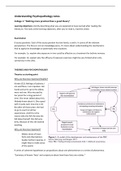College aantekeningen
Understanding Psychopathology lecture notes 2021/2022
- Instelling
- Rijksuniversiteit Groningen (RuG)
This document contains the lecture notes of the course Understanding Psychopathology, given academic year 2021/2022. It is a very elaborate document, containing lots of illustrations and examples. This is a re-upload of the document, as something went wrong on Stuvia's side. This is why I don...
[Meer zien]





